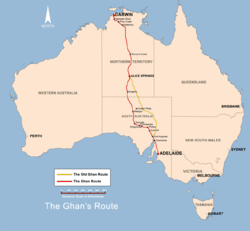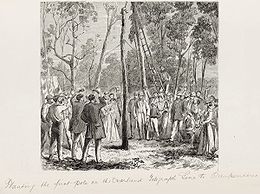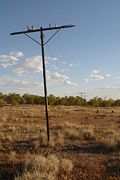
Australian Overland Telegraph Line
Encyclopedia

Telegraphy
Telegraphy is the long-distance transmission of messages via some form of signalling technology. Telegraphy requires messages to be converted to a code which is known to both sender and receiver...
line that connected Darwin
Darwin, Northern Territory
Darwin is the capital city of the Northern Territory, Australia. Situated on the Timor Sea, Darwin has a population of 127,500, making it by far the largest and most populated city in the sparsely populated Northern Territory, but the least populous of all Australia's capital cities...
with Port Augusta
Port Augusta, South Australia
-Electricity generation:Electricity is generated at the Playford B and Northern power stations from brown coal mined at Leigh Creek, 250 km to the north...
in South Australia
South Australia
South Australia is a state of Australia in the southern central part of the country. It covers some of the most arid parts of the continent; with a total land area of , it is the fourth largest of Australia's six states and two territories.South Australia shares borders with all of the mainland...
. Completed in 1872 the Overland Telegraph Line allowed fast communication between Australia
Australia
Australia , officially the Commonwealth of Australia, is a country in the Southern Hemisphere comprising the mainland of the Australian continent, the island of Tasmania, and numerous smaller islands in the Indian and Pacific Oceans. It is the world's sixth-largest country by total area...
and the rest of the world. An additional section was added in 1877 with the completion of the Western Australia
Western Australia
Western Australia is a state of Australia, occupying the entire western third of the Australian continent. It is bounded by the Indian Ocean to the north and west, the Great Australian Bight and Indian Ocean to the south, the Northern Territory to the north-east and South Australia to the south-east...
n section of the line. It was one of the great engineering
Engineering
Engineering is the discipline, art, skill and profession of acquiring and applying scientific, mathematical, economic, social, and practical knowledge, in order to design and build structures, machines, devices, systems, materials and processes that safely realize improvements to the lives of...
feats of 19th century Australia and probably the most significant milestone in Australia's telegraphic history
Australian telegraphic history
Australia was a relatively early adopter of telegraph technology in the middle nineteenth century, despite its low population densities and the difficult conditions sometimes encountered in laying lines. From 1858 onwards, the major capitals were progressively linked, culminating in the addition...
.
Conception and Competition

Albany, Western Australia
Albany is a port city in the Great Southern region of Western Australia, some 418 km SE of Perth, the state capital. As of 2009, Albany's population was estimated at 33,600, making it the 6th-largest city in the state....
in Western Australia
Western Australia
Western Australia is a state of Australia, occupying the entire western third of the Australian continent. It is bounded by the Indian Ocean to the north and west, the Great Australian Bight and Indian Ocean to the south, the Northern Territory to the north-east and South Australia to the south-east...
, or Java to the north coast of Australia and then either onto east coast, or south through the centre of the continent to Adelaide.
Competition between the colonies over the route was fierce. The Victorian
Victoria (Australia)
Victoria is the second most populous state in Australia. Geographically the smallest mainland state, Victoria is bordered by New South Wales, South Australia, and Tasmania on Boundary Islet to the north, west and south respectively....
government organised an expedition
Burke and Wills expedition
In 1860–61, Robert O'Hara Burke and William John Wills led an expedition of 19 men with the intention of crossing Australia from Melbourne in the south to the Gulf of Carpentaria in the north, a distance of around 3,250 kilometres...
led by Burke
Robert O'Hara Burke
Robert O'Hara Burke was an Irish soldier and police officer, who achieved fame as an Australian explorer. He was the leader of the ill-fated Burke and Wills expedition, which was the first expedition to cross Australia from south to north, finding a route across the continent from the settled...
and Wills
William John Wills
William John Wills was an English surveyor who also trained for a while as a surgeon. He achieved fame as the second-in-command of the ill-fated Burke and Wills expedition, which was the first expedition to cross Australia from south to north, finding a route across the continent from the settled...
to cross the continent
Continent
A continent is one of several very large landmasses on Earth. They are generally identified by convention rather than any strict criteria, with seven regions commonly regarded as continents—they are : Asia, Africa, North America, South America, Antarctica, Europe, and Australia.Plate tectonics is...
from Menindee to the Gulf of Carpentaria
Gulf of Carpentaria
The Gulf of Carpentaria is a large, shallow sea enclosed on three sides by northern Australia and bounded on the north by the Arafura Sea...
in 1860. Although the route was traversed, the expedition
Burke and Wills expedition
In 1860–61, Robert O'Hara Burke and William John Wills led an expedition of 19 men with the intention of crossing Australia from Melbourne in the south to the Gulf of Carpentaria in the north, a distance of around 3,250 kilometres...
ended in disaster. The South Australian government recognised the economic benefits that would result from becoming the centre of the telegraph network. It offered a reward of £2000 to encourage an expedition to find a route between South Australia and the north coast.
John McDouall Stuart
John McDouall Stuart
John McDouall Stuart was one of the most accomplished and famous of all Australia's inland explorers. Stuart led the first successful expedition to traverse the Australian mainland from south to north and return, and the first to do so from a starting point in South Australia, achieving this...
had meanwhile also been endeavouring to cross the continent starting from the northern Flinders Ranges
Flinders Ranges
Flinders Ranges is the largest mountain range in South Australia, which starts approximately north west of Adelaide. The discontinuous ranges stretch for over from Port Pirie to Lake Callabonna...
, and was successful on his sixth attempt in 1862. James Chambers had gained an interest in the concept of a telegraph line across the outback. He paid the costs for Stuart's expeditions into northern Australia.
Stuart had the proposed telegraph line in mind as he travelled across the desert, noting the best places for river crossings, sources of timber for telegraph poles, and water supplies. On 24 July his expedition finally reached the north coast at a place Stuart named Chambers Bay, after his employer and sponsor. South Australian Governor Richard MacDonnell
Richard Graves MacDonnell
Sir Richard Graves MacDonnell KCMG CB was an Anglo-Irish lawyer, judge and colonial governor...
gave his strong support to the project.
In 1863 an Order in Council transferred Northern Territory
Northern Territory
The Northern Territory is a federal territory of Australia, occupying much of the centre of the mainland continent, as well as the central northern regions...
to South Australia, aiming to secure land for an international telegraph connection. Now with a potential route, South Australia strengthened her position for the telegraph line in 1865 when Parliament authorised the construction of a telegraph line between Adelaide and Port Augusta, 300 km to the north. This move provoked outrage in Queensland amongst advocates of the Darwin - Burketown route.
The final contract was secured in 1870 when the South Australian government agreed to construct 3200 km of line to Darwin, while the British-Australian Telegraph Company promised to lay the undersea cable from Java to Darwin. The latter was to be finished on 31 December 1871, and severe penalties were to apply if the connecting link was not ready.
Construction
The South Australian Superintendent of Telegraphs, Charles Todd, was appointed head of the project, and devised a timetable to complete the immense project on schedule. Todd had built South Australia's first telegraph line and extended it to Melbourne. The contract stipulated a total cost of no more than ₤128,000 and two years' construction time. He divided the route into three regions: northern and southern sections to be handled by private contractors, and a central section which would be constructed by his own department. The telegraph line would comprise more than 30,000 wrought iron poles, insulators, batteries, wire and other equipment, ordered from EnglandEngland
England is a country that is part of the United Kingdom. It shares land borders with Scotland to the north and Wales to the west; the Irish Sea is to the north west, the Celtic Sea to the south west, with the North Sea to the east and the English Channel to the south separating it from continental...
. The poles were placed 80 m apart and repeater stations built every 250 km.

John Ross (explorer)
John Ross was a Scottish Australian drover and explorer.Ross was born in Bridgend, Scotland. He emigrated to Australia in 1837, arriving in Sydney on 31 August 1837. He first gained employment as a shepherd for George Macleay and in 1838 he joined Charles Bonney in the first cattle drive from the...
. William Dalwood and Joseph Derwent arrived in Darwin on board the SS Omeo with eighty men and the equipment required to construct the Northern section of the line from Darwin to Tennant Creek
Tennant Creek, Northern Territory
Tennant Creek is a town located in the Northern Territory of Australia. It is the fifth largest town in the Northern Territory and it is located on the Stuart Highway, just south of the intersection with the western terminus of the Barkly Highway....
. The southern section from Port Augusta
Port Augusta, South Australia
-Electricity generation:Electricity is generated at the Playford B and Northern power stations from brown coal mined at Leigh Creek, 250 km to the north...
to Alberga Creek was contracted to Edward Meade Bagot.
The northern line was progressing well until the onset of the wet season
Wet season
The the wet season, or rainy season, is the time of year, covering one or more months, when most of the average annual rainfall in a region occurs. The term green season is also sometimes used as a euphemism by tourist authorities. Areas with wet seasons are dispersed across portions of the...
in November 1870. Heavy rain of up to 10 inches (254 mm) a day waterlogged the ground and made it impossible for work to progress. With conditions worsening, the men went on strike on 7 March 1871, rancid food and disease-spreading mosquitoes amongst their complaints. Weeks later the overseer, McMinn decided to rescind the contract for the northern section. The South Australian government was now forced to construct an extra 700 km of line, placing considerable stress on its teams. It was another six months before reinforcements led by engineer Robert Patterson
Robert Patterson
Robert Patterson was a United States major general during the Mexican-American War and at the beginning of the American Civil War...
arrived in Darwin.
As the central and southern sections neared completion, Patterson decided to take a different strategy with the construction of the northern section. It was divided into four sub-sections with the majority of the men on the most northerly section. If the construction deadline of 31 December was missed, then the gap could be filled by using a pony express
Pony Express
The Pony Express was a fast mail service crossing the Great Plains, the Rocky Mountains, and the High Sierra from St. Joseph, Missouri, to Sacramento, California, from April 3, 1860 to October 1861...
. The undersea cable was finished earlier than expected, with the line from Java reaching Darwin on 18 November 1871 and being connected the following day.
Because of the problems still facing the northern section, the Queensland Superintendent of Telegraphs called for the abandonment of the project, but work went on nevertheless. By the end of the year there was still over 300 km of line to erect. During this time Todd began visiting workers along the line to lift their spirits. The message he sent along the incomplete line on 22 May 1872, took 9 days to reach Adelaide.
Completion

- WE HAVE THIS DAY, WITHIN TWO YEARS, COMPLETED A LINE OF COMMUNICATIONS TWO THOUSAND MILES LONG THROUGH THE VERY CENTRE OF AUSTRALIA, UNTIL A FEW YEARS AGO A TERRA INCOGNITA BELIEVED TO BE A DESERT +++
The line proved an immediate success in opening the Northern Territory
Northern Territory
The Northern Territory is a federal territory of Australia, occupying much of the centre of the mainland continent, as well as the central northern regions...
; gold discoveries were made in several places along the northern section (in particular Pine Creek
Pine Creek
Pine Creek may refer to:*In California, USA**Big Pine Creek **Pine Creek, former name of New Pine Creek, California** Pine Creek, *In Colorado, USA**Pine Creek High School**Pine Creek Golf Course...
), and the repeater stations in the MacDonnell Ranges
MacDonnell Ranges
The MacDonnell Ranges of the Northern Territory, are a long series of mountain ranges located in the centre of Australia , and consist of parallel ridges running to the east and west of Alice Springs...
proved invaluable starting points for explorers like Ernest Giles
Ernest Giles
William Ernest Powell Giles , best known as Ernest Giles, was an Australian explorer who led three major expeditions in central Australia.- Early life :...
, W. C. Gosse
William Gosse
William Christie Gosse , explorer, was born in Hertfordshire, England and migrated to Australia with his father in 1850. He was educated at J.L. Young's Adelaide Educational Institution and in 1859 he entered the Government service of South Australia. He held various positions in the survey...
, and Peter Egerton-Warburton
Peter Warburton
Colonel Peter Egerton Warburton CMG was an English explorer who made one particularly daring expedition from Adelaide to cross the centre of Australia to the coast of Western Australia via Alice Springs in 1872.The younger brother of Rowland Egerton-Warburton, Warburton was educated at home and...
who were heading west. Within the first year of operations 4000 telegrams were transmitted. Maintenance was an ongoing and mammoth task, with floods often destroying poles. The extreme remoteness of many of the repeater stations also proved a hazard: on 22 September 1874 Aborigines attacked the station at Barrow Creek
Barrow Creek, Northern Territory
Barrow Creek is a very small town, current population of 11, in the southern Northern Territory of Australia. It is located on the Stuart Highway, about 280 km north of Alice Springs, about half way from there to Tennant Creek. The main feature of the town is the roadhouse/hotel...
, and killed two operators. A policeman stationed there, Samuel Gason, later led a reprisal attack.

SS Gothenburg
The SS Gothenburg was a steamship that operated along the British and then later the Australian and New Zealand coastlines. In February 1875, she left Darwin, Australia en route to Adelaide when she encountered a cyclone-strength storm off the north Queensland coast. The ship was wrecked on the...
. A few days later, they lost their lives in the shipwreck after the Gothenburg hit a section of the Great Barrier Reef
Great Barrier Reef
The Great Barrier Reef is the world'slargest reef system composed of over 2,900 individual reefs and 900 islands stretching for over 2,600 kilometres over an area of approximately...
and sank.
The final stage of connecting Australia to the world was begun in 1875 when the Western Australian and South Australian governments agreed to build a line across the Nullarbor plain. This equally challenging project was completed in 1877.
Around 1871, a second cable connected Java with an overland line from Perth
Perth, Western Australia
Perth is the capital and largest city of the Australian state of Western Australia and the fourth most populous city in Australia. The Perth metropolitan area has an estimated population of almost 1,700,000....
to Roebuck Bay
Roebuck Bay
Roebuck Bay is a bay on the coast of the Kimberley region of Western Australia. Its entrance is bounded in the north by the town of Broome, and in the south by Bush Point and Sandy Point. It is named after HMS Roebuck, the ship captained by William Dampier when he explored the coast of...
.
When Darwin was bombed in World War II
World War II
World War II, or the Second World War , was a global conflict lasting from 1939 to 1945, involving most of the world's nations—including all of the great powers—eventually forming two opposing military alliances: the Allies and the Axis...
the line was deliberately cut just before the attack.
Competition
Before long, competing telegraph line from Java to Roebuck BayRoebuck Bay
Roebuck Bay is a bay on the coast of the Kimberley region of Western Australia. Its entrance is bounded in the north by the town of Broome, and in the south by Bush Point and Sandy Point. It is named after HMS Roebuck, the ship captained by William Dampier when he explored the coast of...
in Western Australia
Western Australia
Western Australia is a state of Australia, occupying the entire western third of the Australian continent. It is bounded by the Indian Ocean to the north and west, the Great Australian Bight and Indian Ocean to the south, the Northern Territory to the north-east and South Australia to the south-east...
opened for business.

